
CAM End of School Year Special on the Military-Industrial Academic Complex
Instead of advancing critical thinking and cultural awareness and compelling students to read great literature, Purdue like many other American universities today is conditioning them to spy on their fellow citizens and fight the new cold war—with machines.
An Associated Press story posted on October 8, 2018, announced that Purdue Global, the new Purdue University online university which was purchased from the discredited Kaplan University, was launching a new degree in “cloud computing.”
As with the general Purdue Global project, there has been little transparency, including consulting the faculty or providing information about it to the public. And the degree is to be partnered with ManTech, “a global leader in technology solutions, to offer the cloud computing program to its employees, supporting ManTech’s portfolio of mission-focused solutions for national security, intelligence community and federal civilian agencies.”
The article emphasized that, by 2020, 59% of the world’s internet consumers will be using cloud storage.

Dr. Jeffrey Buck, who is identified as the “Dean of Purdue Global School of Business and IT,” pointed out that this new cloud computer curriculum will be “developed with real-world requirements and input from experts at ManTech,” and “will help students master the foundational goals of cloud computing.”
ManTech CEO Kevin M. Phillips applauded the “synergy” between this new program and other “cyber certification training.” ManTech employees, he said, will be able to take advantage of “online and self-directed” programs of instruction.
The article points out that the needs of non-traditional students, which are being provided for by Purdue Global’s other courses, will fit this program as well. ManTech’s Chief HR Officer pointed out that it “enhances our tradition of helping ManTech people leverage their experience, build on it and advance their careers in new ways that help safeguard America.”

This story, as with all the publicity surrounding Purdue Global ever since it was unveiled in the spring of 2017, raises more questions than it answers. Who are the students? Who are the faculty? What does the curriculum look like? What role does Purdue University have in the program aside from the use of the Purdue “brand?” How does Purdue University benefit from it? And, of course, what is ManTech?
Searching the internet (not the cloud), one can discover that ManTech is the Department of Defense Manufacturing Technology Program which is the DOD “investment mechanism for staying at the forefront of defense-essential manufacturing capability.”

ManTech was established by law in 1956 and its mandate has been revised periodically. Its current charge includes: the pursuit of the economical acquisition of weapons systems and components; connecting research, development and production; promoting capital investment and industrial innovation; disseminating research and technology throughout the industrial base; promoting worker training; and meeting “other national defense needs with investments directed toward areas of greatest need and potential benefit.”
In short, under the ManTech label, the “cloud computing” educational program, run through Purdue University, is really a collaboration between Purdue Global and the Department of Defense.
The Purdue Global and ManTech cloud-computing plan parallels many of the research activities of Purdue’s Discovery Park.
Discovery Park was launched in 2001 with a grant from the state of Indiana and expanded by a $25 million Lilly Endowment as a nanotechnology center. Today it is a $1.15 billion research and learning complex that combines Purdue’s research and educational expertise in science, engineering, technology, and biology, with connections to the corporate world.
As its website suggests: “Leveraging Lilly Endowment’s investment, Discovery Park has created an innovative environment where major global challenges are examined objectively, generating new ideas and directions for future generations.”

One of Discovery Park’s core strengths is “Global Security.” Key research on this subject is designed to respond to security threats, global instability, defense needs, terrorism, nuclear deterrence, and proliferation, basically responding to “the most pressing security and defense challenges facing the nation and the world.”

To describe this Discovery Park core mission, global security, former Purdue Chief Discovery Park scientist, Professor Tomas Diaz de la Rubia, posted an essay entitled “The New Future of Warfare.” In it he addressed the emerging salience of new military technologies based on artificial intelligence (AI) and war. De la Rubia speculated that future wars will not be fought on battlefields but rather in cities or in cyberspace.
New AI weapons of war in the hands of presumed enemies could constitute an existential threat to the survival of the United States. Discovery Park, he indicated, was already engaged in vital research on biomorphic robots, automatic target recognition for Unmanned Aerial Vehicles, automatic targeting for drones, and other technologies.
In short, this core Discovery Park mission included the preparation for and implementation of war. And this was necessary because, as Professor de la Rubia argued,
“It has become apparent that the U.S. is no longer guaranteed top dog status on the dance card that is the future of war. In order to maintain military superiority, the focus must shift from traditional weapons of war to advanced systems that rely on A.I.-based weaponry. The stakes are just too high and the prize too great for the U.S. to be left behind. All the more reason to call upon Purdue University and its inestimable capacity to weave together academia, research, and industry for the greater good. We’re stepping up to secure our place in the future of our country, and there’s much more to come!”
These articles illustrate Purdue University’s increasing commitment to research, development, training and the production of the instruments of war. Such commitments have been made with little discussion in the broader university community. Important theoretical questions are not being raised. For example, is war inevitable? Are other countries a threat to the United States?
Should the United States commit itself to remaining the number one power in the world, however that is defined? Should not research prioritize human development and conflict resolution rather than “security”? Is there a relationship between poverty, hunger, environmental devastation, the spread of weapons and war and violence?
One wonders if more of government and corporate resources should be allocated to these many issues, rather than to ill-conceived notions of national “security.” And, finally, does a Purdue Global training program in cloud computing best serve the needs of non-traditional students and the society at large or just employees of ManTech?
The Next Frontier: Purdue and the United States Space Force
Purdue is not unique among major research and teaching universities in increasing its focus on the military.
Amidst a looming threat of war with both Russia and China, the Trump administration developed the United States Space Force as a sixth branch of the military, which has penetrated major universities like Purdue.
On September 29, 2021, Purdue President (and former Indiana Governor) Mitch Daniels announced that Purdue had signed a memorandum of understanding to increase research and educational collaboration with the USSF. Ten other universities were also making commitments to work with the USSF.
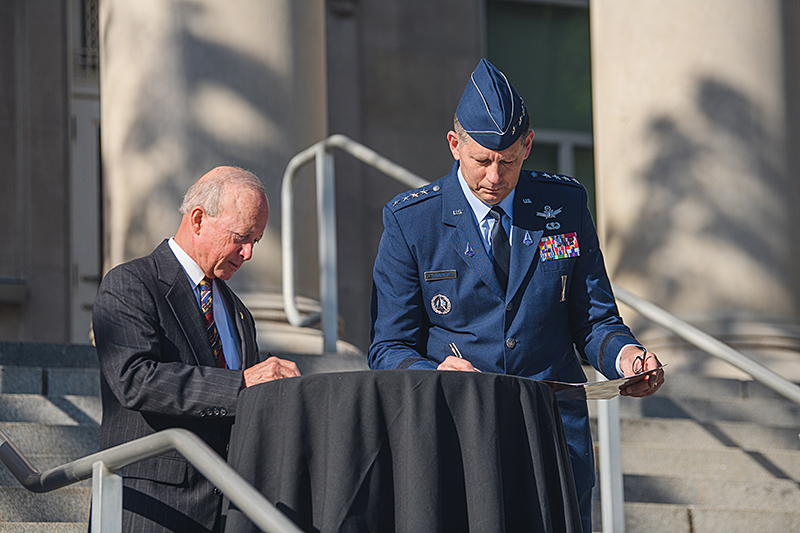
The USSF/Purdue agreement raises at least three concerns:
First, the Purdue arrangement may skew the university’s research agenda further in the direction of militarism. It is possible that the amount of university resources, research and production related to the militarization of space will take away research and educational funds that could be used to address issues of health, the environment, human rights and reducing the likelihood of war.
Congress has been engaged in a conflict over President Biden’s Build Back Better economic program that could serve the needs of the vast majority of Americans. Many of the same congresspeople who oppose the ten-year $3.5 trillion BBB program supported the largest military budget in U.S. history (more than double the size of the proposed BBB program). And now Congress and President Biden are on the verge of approving an additional $40 billion military package to Ukraine (for just a few months), rather than the U.S. government pursuing a diplomatic solution to that terrible war.
Purdue President Daniels has written often about the dangers of deficit spending. Ironically a long-term commitment to building a space force would parallel, if not exceed, expenditures for the fulfillment of human needs.
Second, and President Daniels made this clear, the role of the university is being reconceptualized as an institution that serves United States “national security.” University administrators, ever since the onset of the Cold War in the 1940s, justified support for higher education in “national security” rather than educational terms.
Third, and perhaps most dangerous, the university/USSF connection is justified as a necessity because of the “Chinese threat.” In the dark days of the conflict with the former Soviet Union, trillions of dollars were wasted on both sides in military expenditures, wars were fought all around the globe, and on numerous occasions conflicts almost escalated into nuclear war. The “enemy” was the Soviet Union. Now it is China.
So the USSF and its memorandum of understanding with Purdue University, a new arm of the military and a major university, are collaborating in projects that may be wasteful and dangerous for the stability of the international system.
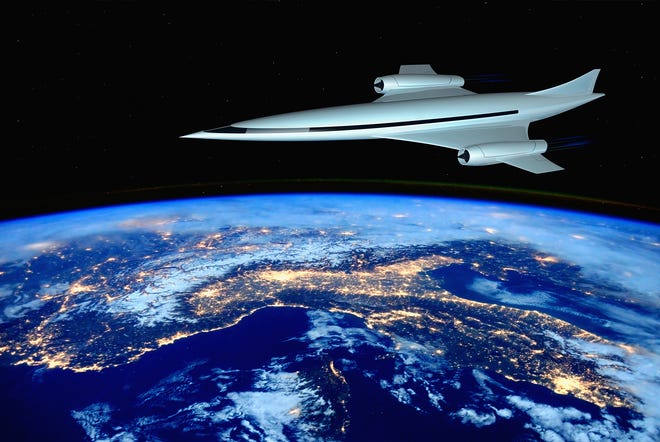
Here Come Raytheon and Rolls-Royce
The Raytheon Technologies Corporation reported that “Raytheon Technologies is working with the University of Arizona, Texas A&M University, Purdue University, the U.S. Air Force Academy and other academic institutions on hypersonic research and testing, to include the use of wind tunnels to emulate flight conditions and accelerate development.”
Raytheon, one of the five largest defense contractors in the world, sold more than $64 billion in military hardware in 2021. Raytheon profits will be higher in 2022 because of the war in Eastern Europe. Recently, Gregory Hayes, the CEO of Raytheon and a Purdue University graduate who was given an honorary doctorate by Purdue’s Krannert School of Management, predicted that the war in Ukraine will be good for his company’s business.

As researchers William Hartung and Julia Gledhill put it: “The war in Ukraine will indeed be a bonanza for the likes of Raytheon and Lockheed Martin. First of all, there will be the contracts to resupply weapons like Raytheon’s Stinger anti-aircraft missile and the Raytheon/Lockheed Martin–produced Javelin anti-tank missile that Washington has already provided to Ukraine by the thousands. The bigger stream of profits, however, will come from assured post-conflict increases in national-security spending here and in Europe justified, at least in part, by the Russian invasion and the disaster that’s followed.”
Another military contractor with ties to Purdue University is the Rolls-Royce Corporation which, according to “Purdue Partnerships at Purdue,” signed a research and development program in 2016 “to create the next generation aircraft agreement with Purdue University.” The partnership resulted in a $33 million jet-engine research and development program to create next-generation aircraft propulsion systems.”
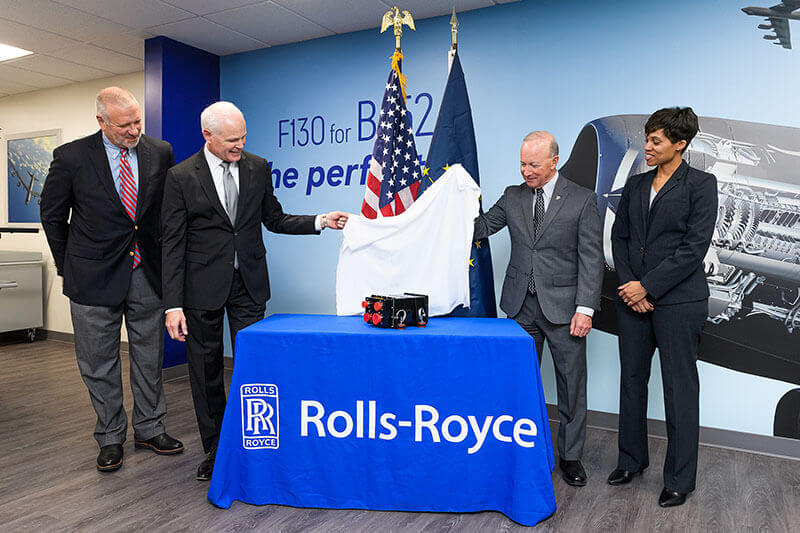
In addition, on April 20, 2022, the company announced a $204 million project to expand one building and two test facilities in the Purdue Discovery Park. Shortly thereafter the West Lafayette government granted the Rolls-Royce Corporation a five-year tax abatement for the construction of facilities in Purdue’s Discovery Park.
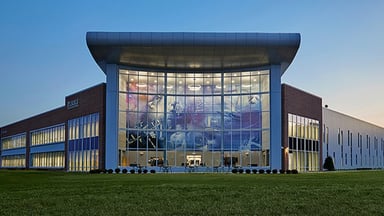
[Source: purdue.edu] 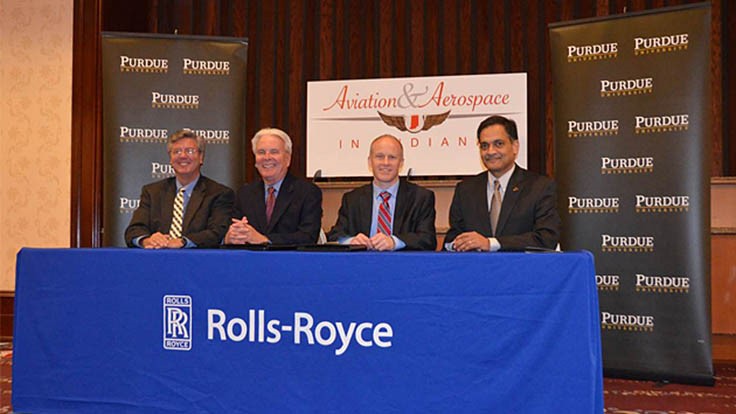
[Source: aerospaceandmanufacturinganddesign.com]
Eisenhower Rolling Over in His Grave

When President Eisenhower gave his final address to the nation on January 17, 1961, more than 60 years ago, he warned of “the acquisition of unwarranted influence” of a military/industrial complex. Some claim he originally included the word “academic” but later eliminated it, for reasons of length. Whatever the case, Eisenhower could have only vaguely envisioned just how entrenched the military-industrial-academic complex has become today—and the extent to which the military has compromised the humanistic mission of universities like Purdue.

CovertAction Magazine is made possible by subscriptions, orders and donations from readers like you.
Blow the Whistle on U.S. Imperialism
Click the whistle and donate
When you donate to CovertAction Magazine, you are supporting investigative journalism. Your contributions go directly to supporting the development, production, editing, and dissemination of the Magazine.
CovertAction Magazine does not receive corporate or government sponsorship. Yet, we hold a steadfast commitment to providing compensation for writers, editorial and technical support. Your support helps facilitate this compensation as well as increase the caliber of this work.
Please make a donation by clicking on the donate logo above and enter the amount and your credit or debit card information.
CovertAction Institute, Inc. (CAI) is a 501(c)(3) non-profit organization and your gift is tax-deductible for federal income purposes. CAI’s tax-exempt ID number is 87-2461683.
We sincerely thank you for your support.
Disclaimer: The contents of this article are the sole responsibility of the author(s). CovertAction Institute, Inc. (CAI), including its Board of Directors (BD), Editorial Board (EB), Advisory Board (AB), staff, volunteers and its projects (including CovertAction Magazine) are not responsible for any inaccurate or incorrect statement in this article. This article also does not necessarily represent the views the BD, the EB, the AB, staff, volunteers, or any members of its projects.
Differing viewpoints: CAM publishes articles with differing viewpoints in an effort to nurture vibrant debate and thoughtful critical analysis. Feel free to comment on the articles in the comment section and/or send your letters to the Editors, which we will publish in the Letters column.
Copyrighted Material: This web site may contain copyrighted material the use of which has not always been specifically authorized by the copyright owner. As a not-for-profit charitable organization incorporated in the State of New York, we are making such material available in an effort to advance the understanding of humanity’s problems and hopefully to help find solutions for those problems. We believe this constitutes a ‘fair use’ of any such copyrighted material as provided for in section 107 of the US Copyright Law. You can read more about ‘fair use’ and US Copyright Law at the Legal Information Institute of Cornell Law School.
Republishing: CovertAction Magazine (CAM) grants permission to cross-post CAM articles on not-for-profit community internet sites as long as the source is acknowledged together with a hyperlink to the original CovertAction Magazine article. Also, kindly let us know at info@CovertActionMagazine.com. For publication of CAM articles in print or other forms including commercial internet sites, contact: info@CovertActionMagazine.com.
By using this site, you agree to these terms above.
About the Author

Harry Targ, Professor of Political Science Emeritus, taught foreign policy, US/Latin American relations, international political economy, and topics on labor studies in the Department of Political Science and the program in Peace Studies at Purdue University.
He has served in the leadership of The Committees of Correspondence for Democracy and Socialism (CCDS) for many years and serves also on the steering committee of Wisconsin Peace Action.
Prof. Targ was a thirty-year member of the Northwest Central Labor Council (AFL-CIO). He has published books and articles on foreign policy and international relations and U.S. political economy.
Harry blogs at Diary of a Heartland Radical. https://heartlandradical.blogspot.com/ and can be reached at targ@purdue.edu.

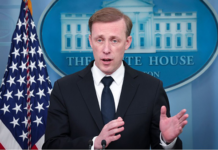



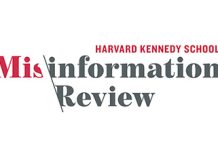




Informative article, Great piece of information for security personnel and industry, Please keep the good work. Know more – https://redscorpionsecurity.in/
A mind-blowing expose of just how far the dire reach of the corporate military-industrial complex is clawing into academia. America is leading the Western world in an evolutionary overshoot that is almost unbelievably crazy and surreal. How has this level of aggressive technological absurdity got such a relentless grip on human intelligence when the path to extinction is so clearly lit?!
Again, as famed astrophysicist/astronomer Carl Sagan warned us in “Cosmos” (1980/1), this path to self-destruction looms because of our obvious inability to control technology, viz climate change, etc. This should be so self-evident and yet is somehow so blindly and stupidly denied. To keep our very sanity – let alone survive! – we must mobilise faster and harder together against this madness!
Understanding of internet and basic typing skill… It’s been an amazing experience working with them and i wanted to zxw share this with you, because they are looking for eed new people to join their team now and i highly recommend to everyone to apply… Visit following page for more information……. https://extrasavingshere1.blogspot.com/